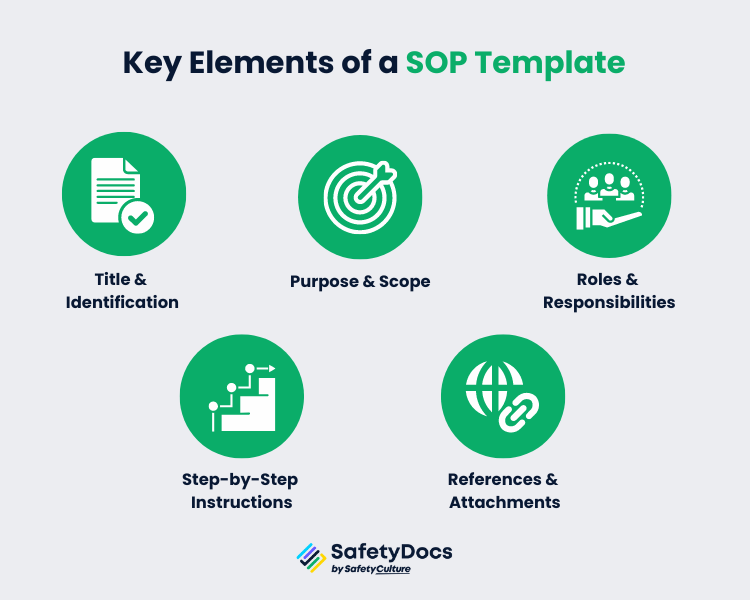A Safe Operating Procedure (SOP) serves as detailed instructions outlining how to perform a task or activity safely. SOPs are useful for any routine, repeated process and are crucial for maintaining workplace health and safety. They provide a stable reference point for all Work Health and Safety (WHS) duties, and their enforcement is mandatory within the workplace.
What is a Safe Operating Procedure?
Safe Operating Procedures (SOPs) are written instructions that outline in detail the step-by-step processes to perform tasks safely and efficiently. These procedures provide clear guidelines for employees, ensuring consistency and minimising the risk of errors or accidents.
An SOP typically includes information such as:
- A description of the task or process, including its purpose and potential hazards
- The equipment, tools, and materials required for the task
- Step-by-step instructions on how to perform the task safely
- Safety precautions and personal protective equipment (PPE) requirements
- Emergency procedures in case something goes wrong
SOPs ensure workplace safety in construction, manufacturing, mining, laboratory work, and healthcare industries. You develop SOPs in consultation with employees and safety experts. Regular review and updates of SOPs are necessary to ensure they remain up-to-date with changing work conditions or hazards.
Standard or Safe Operating Procedure?
The terms "standard operating procedure" (SOP) and "safe operating procedure" (SOP) are commonly interchanged, each referring to a distinct set of protocols. There is no clear consensus on any differences between them. Utilising these terms relies on the company's preference and the nature of the task.
Where to Use SOPs
- New Processes – Before conducting a new process or task, create aStandard Operating Procedures (SOPs) to ensure safe and efficient performance.
- Existing Processes – SOPs are essential for processes, providing written instructions that workers can refer to if something goes wrong or the procedure needs updating.
- Workplace Safety Audits – As part of Workplace Health and Safety (WHS) audits, SOPs can assess a workplace's compliance and processes.
- High-risk Tasks - SOPs are necessary for jobs with a high level of risk, such as using hazardous materials or operating complex machinery.
- Training Initiatives – Having SOPs in place can help train and onboard new staff by outlining processes and safety procedures.
- Quality and Compliance Purposes – SOPs are essential for ensuring quality control and compliance with laws and regulations.
- Routine Activities – SOPs provide consistent instructions for staff to follow when performing everyday tasks.
- Risk Management – SOPs help to minimise workplace risks by outlining safety procedures and precautions.

What are SOP Templates
SOP templates are pre-designed documents that provide a framework for creating standard operating procedures (SOPs) for various tasks or processes. Businesses or organisations of any size can use them to create consistent, standardised safe operating procedures, that help ensure safety, quality, and efficiency.
Templates ensure consistent and efficient creation of SOPs, reducing the time and effort needed for developing new ones from scratch. You can customise templates to fit specific organisational needs or requirements, and they may be available in various formats, including Microsoft Word, Excel, or PDF.
Why Use Templates
Consistency and Standardisation
SOP templates ensure that tasks are performed consistently across the organisation. By providing clear instructions and guidelines, they reduce variations in the execution of tasks and promote standardisation. This consistency helps maintain quality, safety, and efficiency in operations.
Safety and Risk Reduction
Safety is a top priority in any workplace. SOP templates incorporate safety precautions, ensuring employees follow established protocols to identify hazards, minimise risks and prevent accidents. These templates help mitigate hazards and protect employees and assets by providing comprehensive instructions.
Compliance and Regulations
SOP templates assist organisations in complying with industry-specific regulations and standards. They help ensure that legal requirements, industry guidelines, and best practices perform tasks. Compliance with these standards reduces the risk of legal consequences and builds stakeholder trust.
Training and Onboarding
SOP templates serve as valuable resources during employee training and onboarding processes. New hires can refer to these templates to understand the correct procedures for various tasks, reducing the learning curve and improving productivity. Additionally, these templates act as a knowledge repository tool for existing employees to refresh their understanding of established procedures.
Time and Cost Savings
Creating business SOPs from scratch can be time-consuming and resource-intensive. SOP templates streamline the process by providing a starting point, saving time and effort. Organisations can focus on customising the procedures using these templates rather than starting from square one.
Clarity and Comprehension
Well-designed SOP templates enhance clarity and comprehension for employees. By organising information in a structured manner, using headings and bullet points, and incorporating visual aids where necessary, these templates make procedures easier to understand. Clear instructions reduce the chance of misunderstandings, errors, and accidents.
Continuous Improvement
SOP templates promote a culture of continuous improvement. As organisations evolve and new safety practices emerge, these templates can be updated and refined to reflect the latest standards. By regularly reviewing and improving SOP templates, organisations ensure that their procedures stay relevant and effective.

Developing a SOP Template
Key Elements of a SOP Template
When crafting a SOP template, it is imperative to incorporate the following crucial elements:
- Title and Identification: Clearly label the SOP template with a descriptive title that reflects the task or process. Include the date of creation and version number for easy reference and tracking.
- Purpose and Scope: Define the purpose and scope of the SOP template to provide context. Explain why the procedure is essential, whom it applies to, and any limitations or exclusions.
- Roles and Responsibilities: Specify the duties and roles of individuals involved in the task or process. Clearly define who is accountable for each step and outline any necessary qualifications or certifications.
- Step-by-Step Instructions: Provide detailed, sequential instructions for each step of the procedure. Use clear and concise language, breaking down complex tasks into manageable actions. Include any necessary warnings or safety precautions to ensure proper execution.
- References and Attachments: Include references to relevant documents, regulations, or standards that support the procedure. Attach any supplementary materials, such as checklists or forms, that facilitate the execution of the task.
SOP Template Examples
A well-crafted SOP template involves using documentation and tailoring it to the specific task or process it outlines. Here are a few examples of SOP templates for different functions from SafetyDocs:
- Manual Handling Safe Operating Procedure: Outlines the procedures for manual handling activities, such as lifting, carrying, and pushing.
- Excavator Safe Operating Procedure: Details the safety precautions to take before and during an excavator's operation.
- Angle Grinder Safe Operating Procedure: Describes how to use an angle grinder safely, such as selecting the correct disk and wearing the necessary safety equipment.
- Scissor Lift Safe Operating Procedure: Guides operators on adequately using a scissor lift, including inspection and maintenance procedures.
- Chemicals Safe Operating Procedure: Describes the procedures for working with hazardous chemicals, including proper storage and disposal.
- Warehouse Safe Operating Procedure: Outlines safety protocols to follow while working in a warehouse, such as housekeeping and material storage safety processes.
- LPG Forklift Safe Operating Procedure: LPG-powered forklifts pose additional safety risks due to flammable gases. This SOP template provides instructions on how to operate these vehicles safely.
- Chain Saw Safe Operating Procedure: This SOP template outlines the safety protocols for using a chain saw, including protective clothing and proper inspections.
- Fuel Storage and Handling - Portable Safe Operating Procedure: This template provides instructions on proper storage, including fuel transport and pre-inspection of containers and equipment.
- Platform Ladder Safe Operating Procedure: Outlines the step-by-step protocols for using platform ladders, such as ensuring they are set up correctly and proper transportation.

Best Practices for Implementing SOP Templates
To maximise the effectiveness of SOP templates, consider the following best practices:
- Involve relevant stakeholders: Collaborate with subject matter experts and employees using the SOP templates to gather insights and ensure accuracy.
- Keep it simple and concise: Use plain language, avoid jargon, and present information clearly and concisely.
- Incorporate visual aids: Where appropriate, use diagrams, flowcharts, or images to enhance understanding.
- Make it accessible: Ensure the SOP templates are easily accessible to employees through a centralised repository or document management system.
- Provide training and support: Conduct training sessions to educate employees on how to use SOP templates effectively. Offer ongoing support and address any questions or concerns.
To ensure complete compliance with SOP templates, organisations should:
- Conduct regular audits and inspections to verify adherence to SOPs.
- Provide appropriate training and resources to address any non-compliance issues.
- Document deviations from SOPs and investigate the root causes to prevent recurrence.
- Continuously promote a culture of compliance and safety awareness.
SafetyDocs for All Your SOP Templates Need
SafetyDocs by SafetyCulture is a reliable and efficient resource for organisations seeking to write and implement adequate safety operating procedures. Creating SOPs can be complex, so we offer a comprehensive library of SOP templates to streamline the process.
We cater to various industries, such as Agriculture, Warehousing, Cleaning Services, and Security. With SafetyDocs, you can ensure compliance with regulatory standards and minimise risks in the workplace. Plus, we offer the following:
- Bonus training quizzes with every SOP template
- Instant document delivery via email makes it easy to access the necessary documents quickly and efficiently
- Step-by-step processes for safety protocols that are easy to understand and follow
- Employee training and induction register
- Customisation instructions to help businesses adapt the templates to their specific needs quickly
- Editable on the go with the Microsoft Office Mobile App
- One-time fee, with no subscriptions required, for affordable access to the most up-to-date safety procedures
Choose SafetyDocs for all your standard operating procedure template needs and experience the benefits of streamlined safety procedures in the workplace. Contact us today to learn more, or discover SOPs for your workplace using the finder below!
Our team of experts is dedicated to providing accurate and informative content. Craig Cruickshank, our senior HSEQ advisor at SafetyDocs by SafetyCulture has reviewed this blog post to ensure the highest level of quality.
Learn more about Craig's work on LinkedIn for more industry insights.
Available for instant download and supplied in fully editable MS Word format for use in your business.
Please note that the above information is provided as a comment only and should not be relied on as professional, legal or financial advice.
Share This Article
